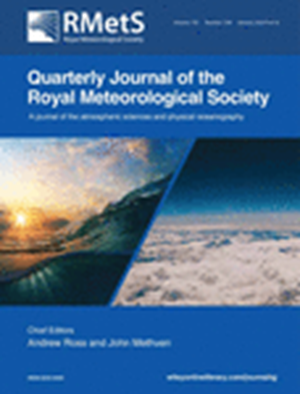The meteorology of the 2019 North Queensland floods
IF 2.9
3区 地球科学
Q2 METEOROLOGY & ATMOSPHERIC SCIENCES
引用次数: 0
Abstract
In January–February 2019, a monsoon low developed over northeastern Australia and brought extreme flooding to much of tropical Queensland. The European Centre for Medium Range Weather Forecasts reanalyses are used to explain the formation and severity of the event. Strong anticyclonic Rossby wave breaking to the southeast of Australia produced weak steering winds over northern Australia, and consequently the low remained nearly stationary for over a week, contributing to the extreme rainfall. Furthermore, the tropical moist margin was deformed by a series of disturbances along the monsoon trough, which drew moist maritime air over land. The event examined has much in common with the composite mean of slow‐moving potential vorticity anomalies in North Queensland, including weak background winds and heavy precipitation. An ensemble subseasonal forecast with the Australian Bureau of Meteorology's Australian Community Climate and Earth System Simulator Seasonal prediction version system 1 shows the same relationship between the background flow, the steering, and the subsequent rainfall. Hence, accurately forecasting the background winds is a prerequisite to forecasting such extreme rainfall.2019 年北昆士兰洪水的气象学特征
2019 年 1 月至 2 月,澳大利亚东北部上空出现了季风低气压,给热带昆士兰的大部分地区带来了特大洪水。欧洲中期天气预报中心的再分析被用来解释这一事件的形成和严重程度。澳大利亚东南部强烈的反气旋罗斯比波在澳大利亚北部上空产生了微弱的转向风,因此低气压在一周多的时间里几乎保持静止,导致了极端降雨。此外,季风槽沿线的一系列扰动使热带潮湿边缘发生变形,从而将潮湿的海洋空气引向陆地。所研究的事件与北昆士兰缓慢移动的位势涡度异常综合平均值有许多共同之处,包括弱背景风和强降水。澳大利亚气象局的澳大利亚社区气候和地球系统模拟器季节预测版本系统 1 进行的集合分季节预测显示,背景气流、转向和随后的降雨量之间存在相同的关系。因此,准确预报背景风是预报此类极端降雨的先决条件。
本文章由计算机程序翻译,如有差异,请以英文原文为准。
求助全文
约1分钟内获得全文
求助全文
来源期刊
CiteScore
16.80
自引率
4.50%
发文量
163
审稿时长
3-8 weeks
期刊介绍:
The Quarterly Journal of the Royal Meteorological Society is a journal published by the Royal Meteorological Society. It aims to communicate and document new research in the atmospheric sciences and related fields. The journal is considered one of the leading publications in meteorology worldwide. It accepts articles, comprehensive review articles, and comments on published papers. It is published eight times a year, with additional special issues.
The Quarterly Journal has a wide readership of scientists in the atmospheric and related fields. It is indexed and abstracted in various databases, including Advanced Polymers Abstracts, Agricultural Engineering Abstracts, CAB Abstracts, CABDirect, COMPENDEX, CSA Civil Engineering Abstracts, Earthquake Engineering Abstracts, Engineered Materials Abstracts, Science Citation Index, SCOPUS, Web of Science, and more.

 求助内容:
求助内容: 应助结果提醒方式:
应助结果提醒方式:


